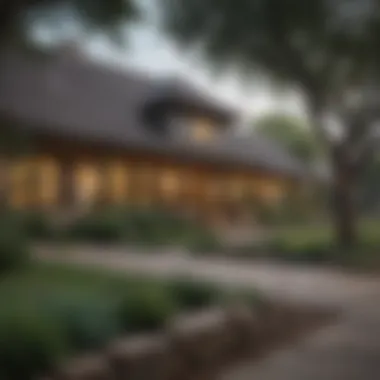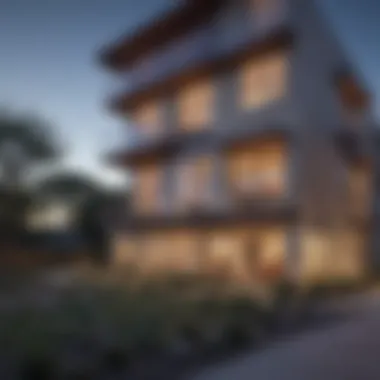Explore the Best Neighborhoods in the Austin Area


Intro
Austin, known for its vibrant culture, technology hub, and diverse communities, offers a variety of neighborhoods suitable for different lifestyles. When considering a relocation, understanding the characteristics of various areas is vital. This article aims to analyze important aspects like demographics, cost of living, accessibility, and lifestyle offerings in the Austin area. By breaking down each neighborhood, readers can gain a clearer picture of where they might fit in the dynamic fabric of this city, helping them make informed decisions about their move.
Inspiring Homes
In the Austin area, residences range from modern apartments to charming historic homes. This variety is appealing for anyone considering a move here.
Luxury Properties
For individuals seeking opulence, neighborhoods such as West Lake Hills and Tarrytown boast several luxurious estates. These areas feature grand mansions set on sprawling lots, often with stunning views of Lake Austin. The real estate market in these neighborhoods reflects exclusivity, with prices that can reach several million dollars.
Cozy Retreats
On the other hand, neighborhoods like South Congress offer a more intimate atmosphere, perfect for those desiring a cozy retreat. The charming bungalows often come with character and a sense of community. These homes, while smaller, provide a welcoming ambience that many find appealing. Residents appreciate the accessibility to local shops and eateries, contributing to a more relaxed lifestyle.
Unique Architectural Styles
The architectural landscape in Austin is diverse. From contemporary designs in places like Mueller to historic Victorian homes in the Sendero Hills area, prospective homeowners will find various styles to match their tastes. This mix not only enhances the aesthetic appeal but also reflects the city's commitment to preserving history while embracing innovation.
Stunning Locations
Austin is well-known for its beautiful landscapes and vibrant urban centers. Its locations greatly contribute to its desirability.
Cityscapes
The urban experience in downtown Austin is lively, characterized by high-rise buildings, trendy restaurants, and cultural venues. The city's skyline presents a modern architectural marvel that attracts both tourists and residents alike. This area is perfect for those who appreciate an energetic lifestyle filled with activities and opportunities.
Natural Wonders
Conversely, the natural landscapes surrounding the city offer a peaceful counterbalance to the urban hustle. Parks like Zilker Park and Lake Travis provide residents with outdoor spaces for recreation and relaxation. The accessibility to natural wonders is a significant attraction for those who value outdoor activities.
Real Estate Market Insights
Understanding the real estate market in the Austin area is crucial for potential buyers. The market is remarkably dynamic, influenced by various factors.
Market Trends
Currently, Austin's real estate market is experiencing high demand, driven by its growing population and job opportunities. Prices have been on the rise, making it essential for prospective buyers to stay informed. Keeping an eye on market trends will assist in making strategic decisions regarding purchasing property.
Buying Guides
Navigating the real estate market can be daunting. A step-by-step guide for purchasing properties can simplify the process. Important considerations include getting pre-approved for a mortgage, choosing a knowledgeable real estate agent, and thoroughly researching neighborhoods.
It is recommended to spend time in prospective neighborhoods to gain a better insight into the community's vibe and lifestyle.
With the information provided in this article, potential residents can approach their search for the perfect home in the Austin area with confidence. By analyzing different neighborhoods and understanding the real estate market, they will be better equipped to make an informed choice.
Preface
The process of choosing a place to live is among the most significant decisions one may undertake. Austin, Texas, stands out as an attractive option for many due to its unique blend of culture, opportunity, and lifestyle. The city has a fluctuating population that is drawn to its vibrant music scene, tech industry, and rich culinary offerings. Furthermore, Austin’s neighborhoods provide distinct atmospheres, catering to diverse preferences and needs.
Understanding where to live involves examining several crucial factors. Accessibility to work, schools, and amenities weighs heavily on the minds of potential residents. Families, young professionals, and retirees each have different priorities. Thus, a comprehensive view of Austin’s neighborhoods can provide insightful clarity.
Moreover, real estate dynamics in the region are continually changing. This adds another layer of complexity for those unfamiliar with the market. Recent trends indicate both growth and competition in housing, placing pressure on buyers and renters. Not only do residents seek homes, but they also desire a community that aligns with their values and lifestyle.


This article serves as a guide, offering an overview of areas that are noteworthy for consideration. It highlights real estate opportunities, community amenities, and other elements crucial for making informed decisions. Readers should gain a clearer understanding of what to expect in various neighborhoods, ensuring that their eventual choice aligns with their personal needs and aspirations.
In short, this exploration of Austin’s neighborhoods aims to arm potential residents with knowledge and insights essential for navigating one of Texas's most dynamic cities. The intention is to simplify the daunting process of relocation by providing valuable, detailed information.
Overview of Austin's Real Estate Landscape
Austin, Texas, has been experiencing significant growth in its real estate landscape. The city is known for its vibrant culture, technological advances, and appealing lifestyle. Understanding the current market trends and investment opportunities is vital for anyone considering a move to the area.
The real estate market in Austin is characterized by a unique combination of high demand and limited inventory. This situation can create a competitive environment for buyers. It is essential to examine not just the prices, but also the underlying factors that contribute to these trends.
Current Market Trends
In recent years, Austin's real estate market has shown a steady appreciation in home values. The city consistently ranks as one of the fastest-growing metropolitan areas in the United States. Many factors drive these trends, including:
- Job Growth: Austin has a thriving job market, particularly in technology, healthcare, and education sectors. Companies like Dell, Apple, and Google have substantial operations here. As employment opportunities increase, more people relocate to the area.
- Population Growth: The population of Austin has surged. Many individuals are drawn to the city's lively atmosphere and rich cultural offerings, further intensifying the housing demand.
- Price Increase: The increase in demand has led to rising home prices. Data shows that housing prices have surged by over 20% year-over-year. For potential homeowners, this trend necessitates careful planning to ensure affordability.
"Austin's real estate market is an intricate dance of supply and demand influenced by migration patterns, employment opportunities, and urban developments."
Staying aware of these market trends is crucial for potential residents and investors interested in navigating Austin's real estate landscape.
Investment Opportunities
For investors, Austin's real estate market presents multiple opportunities. The city’s consistent growth and vibrant economy attract not only individuals looking to purchase a home but also those interested in investment properties. The key factors to consider in this regard include:
- Rental Market Growth: With a high influx of new residents, the demand for rental properties increases. Investors can expect consistent rental yields in popular neighborhoods.
- Commercial Real Estate: As more businesses establish themselves in Austin, commercial real estate opportunities continue to expand. Investing in areas with burgeoning commercial prospects may yield high returns.
- Emerging Neighborhoods: Some neighborhoods, still relatively affordable, are gaining popularity. Areas like East Austin and North Austin have shown signs of rapid development. Recognizing these potential hotspots can provide investors with excellent opportunities for growth.
- Government Incentives: Understanding local policies can also present investment advantages. Some programs support property owners who contribute to community developments or renovations, offering financial incentives.
Austin’s real estate landscape is rich with possibilities. With its dynamic market, it is essential for both potential residents and investors to conduct thorough research and capitalise on the unique opportunities it presents.
Criteria for Selecting the Best Places to Live
When considering a move to the Austin area, selecting the best neighborhood is not merely about convenience; it entails a thorough evaluation of several key criteria. These factors shape the living experience and influence aspects such as daily comfort and long-term satisfaction. Evaluating these criteria allows potential residents to make informed decisions that align with their personal values and lifestyle preferences.
Accessibility and Transportation
Accessibility plays a crucial role in the desirability of a neighborhood. Central locations usually offer proximity to public transport systems, such as Capital Metro. This accessibility eases commuting for those who work in downtown Austin but live in the suburbs. Additionally, neighborhoods with well-maintained roads support efficient navigation by car, which is vital given Austin's traffic patterns. Walkability is another important facet. Areas with pedestrian-friendly features can significantly enhance the quality of life, making it easier to access shops, restaurants, parks, and community spaces without relying solely on vehicles.
Educational Facilities
For families, the presence of quality educational institutions is paramount. The Austin area boasts several highly rated public and private schools, most notably those operated by the Austin Independent School District. Access to higher educational facilities, such as the University of Texas at Austin, also adds value to neighborhoods, attracting families and individuals keen on educational growth. Prospective residents often consider factors like school rankings, extracurricular options, and educational philosophies when evaluating neighborhoods.
Community Amenities
A neighborhood's community amenities can significantly enhance the appeal of a location. Parks, recreational facilities, shopping centers, and libraries contribute to a vibrant community atmosphere. Neighborhoods such as Circle C Ranch offer extensive amenities, including community pools, sports fields, and trails. Social clubs and local events provide opportunities for residents to engage with each other, enhancing social cohesion. A neighborhood with rich community amenities not only supports an active lifestyle but also fosters a sense of belonging.
Demographics and Lifestyle
Understanding demographics helps potential residents gauge whether a neighborhood aligns with their lifestyle. Factors such as age distribution, income levels, and cultural diversity affect community dynamics. Some neighborhoods like Downtown Austin may appeal to younger, more urban-oriented individuals, while areas like West Lake Hills may attract families seeking quieter, suburban environments. Personal lifestyle choices, including social preferences and daily routines, influence what demographics are most compatible. A neighborhood that resonates with the individual’s values and lifestyle tends to be more fulfilling and satisfying.
Understanding these criteria enables potential residents to navigate Austin's diverse neighborhoods with clarity.
In summary, the criteria for selecting a place to live in the Austin area encompass accessibility, educational facilities, community amenities, and demographics. Each factor provides valuable insight into the overall living experience. Residents who thoroughly evaluate these elements are better equipped to find a neighborhood that truly meets their expectations and lifestyle needs.
Notable Neighborhoods in Austin
Understanding notable neighborhoods in Austin is critical for anyone considering a move to the area. Each neighborhood offers unique advantages and lifestyle options. Factors like culture, amenities, and housing can contribute significantly to the choice of where to live. Given Austin's rapid growth, it's essential to analyze these neighborhoods more closely. This review assists potential residents in making informed choices about where they might thrive best.
Downtown Austin


Cost of Living
The cost of living in Downtown Austin is a topic of interest. It tends to be higher compared to some other areas. However, this is often offset by the vibrant lifestyle and convenience it offers. Rent prices vary, but many see value in the access to amenities like shops and restaurants. This area attracts young professionals and students who appreciate being at the heart of the city's cultural scene. Yet, high expenses might deter some families or retirees.
Vibrant Culture
Downtown Austin stands out for its vibrant culture. The area is home to music festivals, art galleries, and diverse dining options. Residents can enjoy live music nearly every night. This contributes to a lively atmosphere that fosters community engagement. The unique cultural activities here are a major pull for new residents. However, some may find the constant activity overwhelming.
Real Estate Options
Real estate options in Downtown Austin range from modern condos to historic buildings. Many seek these properties for their convenience and lifestyle offerings. The variety allows potential buyers or renters to choose what suits their needs best. However, competition can drive prices up, making it essential for interested parties to act quickly.
South Congress (SoCo)
Art and Entertainment
South Congress is renowned for its rich art and entertainment scene. The streets are lined with independent shops and local artists showcasing their work. This artistic vibe attracts those who appreciate a creative lifestyle. Events and exhibitions are frequent, making it a hotspot for new residents. That said, the area can be quite busy, which may not appeal to everyone.
Community Vibe
The community vibe in SoCo is friendly and inviting. Locals often engage in neighborhood events and markets. This fosters a sense of belonging, which many find appealing. It is popular among younger crowds and art enthusiasts. However, the increasing popularity means it can feel crowded, especially on weekends.
Housing Market
The housing market in South Congress shows steady demand. Prices can fluctuate, influenced by its popularity and location. Those looking to rent or buy must be prepared for the competitive nature. Properties here might offer a unique charm but often come with a premium price tag.
East Austin
Transformation and Gentrification
East Austin has seen substantial transformation in recent years. This progress includes new developments and businesses moving in. While this brings fresh opportunities, it also raises concerns about gentrification. Some long-time residents worry about being priced out. Therefore, potential newcomers must consider both the benefits and challenges of living in this evolving area.
Local Businesses
Local businesses thrive in East Austin, contributing to its vibrant character. Many establishments focus on sustainability and unique products. This creates an appealing shopping and dining experience for residents. Supporting these local vendors often fosters a strong community spirit. Yet, as the area gentrifies, there may be a decline in long-standing local businesses.
Living Environment
The living environment in East Austin reflects its dynamic character. There are parks, art scenes, and diverse eateries. Residents often enjoy outdoor activities and community gatherings. However, some parts may still struggle with infrastructure and amenities, which can affect daily life.
North Austin
Residential Options
North Austin offers a variety of residential options for families and individuals. From apartments to spacious single-family homes, there is something suitable for everyone. Pricing remains more accessible compared to other parts of the city. This attracts a mix of residents, from young professionals to families seeking more space. Accessibility can be an issue in some areas, requiring careful consideration.
Family-Friendly Atmosphere
The family-friendly atmosphere in North Austin is praised by many. There are several excellent schools and community centers. Parks offer recreational opportunities, making it ideal for families with children. The sense of community here is strong, though some areas might feel less lively than others.
Proximity to Parks
Proximity to parks is a valuable trait of North Austin. Many neighborhoods are adjacent to recreational areas, providing space for outdoor activities. Families often enjoy weekend picnics and sports activities in these parks. However, some parks may not be well-maintained, impacting user experience.
West Lake Hills


High-End Living
West Lake Hills is famous for its high-end living. Properties here tend to be luxurious and spacious, attracting affluent buyers. The area’s exclusivity provides a serene lifestyle. It's a great choice for those prioritizing private living spaces. Higher costs can be a limitation for some potential residents.
Outstanding Schools
The presence of outstanding schools in West Lake Hills attracts families. Many highly-rated educational institutions serve the area, ensuring quality education. This aspect is essential for families making a relocation decision. However, the competitive nature and high property values can be a barrier.
Scenic Views
Scenic views are one of the highlights of West Lake Hills. The landscape offers picturesque vistas, which enhance the living experience. Many properties capitalize on these views, allowing residents to enjoy a tranquil atmosphere. However, residents must consider the added maintenance and costs related to high-end homes.
Circle Ranch
Suburban Lifestyle
Circle C Ranch embodies a suburban lifestyle that many find appealing. This neighborhood is family-oriented, with parks and community pools. It offers a sense of safety and community engagement. Ideal for those raising families, but may lack some urban conveniences.
Parks and Recreation
Parks and recreation options in Circle C Ranch are excellent. Many green spaces and trails encourage outdoor activities. Residents frequently enjoy hiking, biking, and family outings. This focus on recreation adds to the attractiveness of the community. However, some amenities might require a drive to access.
Community Facilities
Community facilities in Circle C Ranch enhance the living experience. Multipurpose areas support events and gatherings, fostering community ties. Schools and shopping centers are accessible, making daily life easier. Some residents may find the growth leads to more crowded spaces, which can impact the community feel.
Cost of Living in Different Areas
Understanding the cost of living in various areas around Austin is critical for potential residents. This aspect significantly influences overall quality of life and financial wellbeing. Each neighborhood presents different housing prices, taxes, and utility rates. Exploring these factors helps individuals determine where they can comfortably afford to live while also meeting their lifestyle expectations.
Cost of living is not only about housing; it encapsulates a wide array of day-to-day expenses. The comparison between suburban and urban areas, for example, sheds light on how living costs can vary dramatically. This section will provide insights into housing affordability and the necessary utilities and expenses that come with living in Austin and its surrounding areas.
Housing Affordability
When one looks at housing affordability, it includes home prices, rental rates, and the overall financial feasibility for households. In Austin, the housing market can fluctuate. Due to its growth trajectory, prices in neighborhoods like Downtown Austin or South Congress can be significantly higher than in places like Circle C Ranch or North Austin.
- In 2023, the median home price in Austin was around $600,000, representing a rise over the years.
- Renting in urban areas can easily cost over $2,000 a month. In contrast, suburban rentals may average closer to $1,500.
It's also worth noting the impact of interest rates on mortgage affordability. As rates rise, more individuals find it increasingly challenging to afford homes, especially first-time buyers. This adds complexity to the housing market and can push potential buyers to consider less expensive areas.
Utilities and Expenses
Utilities, which include electricity, water, and internet, can add a significant amount to monthly costs. In Austin, residents can expect to pay the following on average:
- Electricity: approximately $160 per month
- Water: around $40 per month
- Internet: about $60 per month
These are averages and can vary by neighborhood. In addition, taxes play a role in overall costs. Property taxes in Travis County, for example, can be higher than in neighboring counties, which affects overall affordability and budgeting considerations.
Additionally, transportation costs can impact living expenses. Commute times and distances influence whether people choose to drive or use public transit, which can shift expenses more broadly.
"Careful budgeting and understanding the cost dynamics are essential for making informed decisions when relocating in the Austin area."
Ultimately, assessing the cost of living in different areas of Austin provides a comprehensive view of affordability and helps residents make better decisions aligned with their financial capacities.
The End
Consideration for factors such as accessibility, educational opportunities, and local culture cannot be overstated. When individuals or families choose a neighborhood, they must reflect on personal lifestyle priorities and needs. Each area, from Downtown Austin to Circle C Ranch, offers unique attributes that cater to different preferences.
Furthermore, the real estate landscape in Austin continues to evolve, presenting both challenges and opportunities. Knowing where to invest or rent is essential.
"The best place to invest depends on personal situation. Understand your needs."
In summary, this article provides valuable insights aimed at helping readers make educated decisions about moving to the Austin area. By synthesizing information from the entire discussion, we underline the need for careful consideration and the substantial impact of choosing the right neighborhood. Readers are encouraged to explore each neighborhood thoroughly, aligning their choice with their lifestyle needs and expectations. This conclusion solidifies the ongoing dialogue about living in Austin, serving as a guiding principle for future residents.



